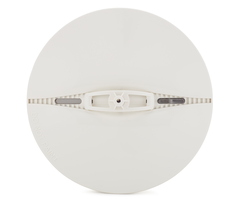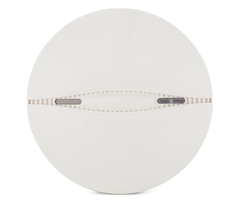How Do I Properly Test My PowerG Smoke Detector?
You can properly test your PowerG Smoke Detector by enrolling the device with the panel, putting your system on test mode, and then using canned smoke or the device's test button to test the device. After testing, you can clear the fire alarm and take your system off of test mode.

Testing your smoke detectors regularly is very important. As these are life-safety devices, a faulty smoke detector could have serious consequences. We recommend performing a monthly test to ensure that these devices are working properly. If you have a certificate of alarm (CoA) to save money on your homeowner's insurance, then you will need to perform an annual test to receive an updated CoA. This annual test involves making sure that your system can successfully report fire alarm signals to the central station. You will receive an updated CoA upon the completion of a successful test.
Complete the following steps to test your PowerG Smoke Detector:
1. Program to the panel. Your PowerG Smoke Detector must be properly enrolled with your panel before you can conduct a test. If you have a Qolsys IQ Panel 2 Plus or DSC PowerSeries NEO Panel, then you can program the sensor to the panel by first putting the system into its wireless enrollment mode. Then press and hold the enrollment button on the device until the LED light is steady. Then release the button. The system should acknowledge the sensor and allow you to enroll it. If you have a DSC Iotega System, then you will need to contact your alarm monitoring company to help you, because the Iotega does not offer local programming. Continue to the next step once you are sure that your PowerG Smoke Detector is enrolled with your panel.
2. Enter test mode. If you have service with a central monitoring station, you must put your system on test mode before testing the smoke detector. Failure to do this could result in emergency dispatch from your local fire department and a hefty false alarm fine. If you are an Alarm Grid customer, the best way to put your system on test mode is to contact our central station partner Criticom Monitoring Services directly. Alternatively, you can also put your system on test mode yourself using the MyAlarms.com feature or by emailing support@alarmgrid.com. If you decide to email us, make sure that you receive a confirmation email from us stating that your system has been placed on test mode before you actually conduct the test.
3. Test the sensor. With your system on test mode, you can now perform the actual test on your PowerG Smoke Detector. The test button on the device will let you confirm that the sensor can transmit signals to the panel properly. But if you want to test the actual functionality of the sensor, you will need to use canned smoke. Hold the can of smoke close to the sensor, and direct the smoke into the sensor vents. You may also use a burning cotton ball to conduct the test. Remember, the PowerG PG9926 only offers smoke detection. However, the PowerG PG9916 offers both smoke detection and heat detection. Since heat detection is not considered a life-safety concern, there is no need to do a functional test of the built-in heat detector.
4. Confirm the alarm. If the PowerG Smoke detector is working properly, you should get an alarm on your system. You can clear the alarm by entering your Master Code at the panel. The Master Code is the code that you should typically use to arm and disarm your panel. If no alarm occurs, then it is possible that something is wrong with your PowerG Smoke Detector. Conduct any necessary troubleshooting steps, including making sure that the sensor is programmed with your system properly. Regarding sensors that have been installed for some time, you may use a vacuum cleaner to remove dust from the detection vents. Then perform the test again, and make sure that it works properly. If necessary, replace the PowerG Smoke Detector with a new one.
Did you find this answer useful?
We offer alarm monitoring as low as $10 / month
Click Here to Learn MoreRelated Products


Related Videos
Related Categories
- Answered

